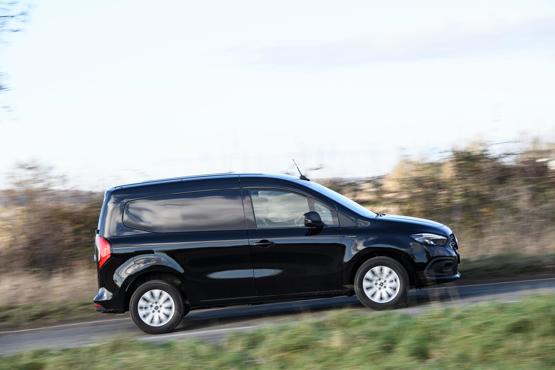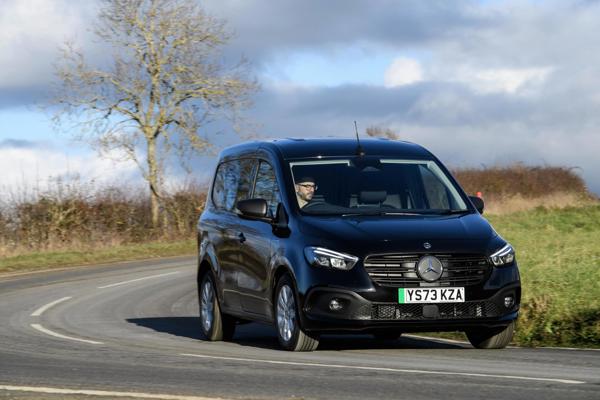Review
The long-awaited replacement for the Mercedes-Benz Citan has finally arrived. And it’s worth the wait. The model has been on sale in Europe since 2021, but it has taken almost two years for it to arrive in the UK.
Available now as a fully electric model, for the first time, the eCitan is offered alongside a diesel powered Citan.
As before, the Citan shares a platform with the Renault Kangoo. Development of the latest model has seen the implementation of more car-derived components, which gives the eCitan improved refinement, handling and technology.
The van’s capability has also improved, significantly. There are two lengths (L1 and L2) offering load volumes of 2.9 cubic metres and 3.6 cubic metres.
The payload is 425Kg (excluding driver) for the L1 and is yet to be confirmed for the L2. Comparatively, the Renault Kangoo E-Tech offers payloads of 608Kg (short) and 764Kg (long).

As well as competing with the Kangoo, the eCitan will also enter battle against the Ford E-Transit Courier and the Stellantis family of small vans, the latter of which have just been updated.
The eCitan’s electric powertrain has a power output of 122PS and 245Nm. Power is sent to the front wheels. Energy is stored in a 45kWh battery, giving a WLTP range of 175 miles.
During our tests, the van acheived 3.1mi/kWh in real-world driving conditions, suggesting a range of around 140 miles is possible between charges.
Charging the battery takes six-and-a-half hours using a 7kW wallbox, while a rapid charger can provide a 10-80% top-up in 38 minutes. The eCitan supports AC charging at up to 22kW and DC charging at up to 75kW.
The eCitan has a relatively compact footprint, which makes it easy to drive in urban environments. Combined with its car-derived underpinnings, the van’s driveability is excellent. It provides stable handling with limited body roll. Acceleration is modest, rather than rapid, but it will reach the national speed limit effortlessly and is happy to cruise on the motorway.
Mercedes-Benz has given the eCitan a unique dashboard, which integrates the MBUX infotainment system and an analogue instrument cluster. There’s also a Mercedes steering wheel, with integrated controls for the trip computer, cruise control and audio system.
Other parts of the interior, such as the door panels and climate controls are carried over from the Kangoo. Overall, the interior is a pleasant place to be. There’s plenty of storage, including a large overhead compartment. The seats are comfortable although adjustment is limited due to the fixed bulkhead. Taller drivers may find it a little cramped.

On the move, the eCitan is refined and quiet. It generates little wind noise until you reach motorway speeds. Ride quality is also impressive, while the lack of noise and vibration at low speeds helps to reduce driver fatigue.
The eCitan comes packed with equipment as standard. The entry-level Progressive model comes with heated front seats, air conditioning with pre-entry climate control via smartphone app, rear parking sensors, a reversing camera, an electronic parking brake and a seven-inch touchscreen infotainment system with sat-nav.
Stepping up to the Premium adds body coloured bumpers, LED headlights with high-beam assist and alloy wheels.
Mercedes is also including a four-year inclusive service and maintenance plan with every eCitan model as well as its MobiloVan breakdown and assistance cover. The provision includes an out of charge cover, whereby the brand will recover any stranded eCitans back to a charger if the battery runs out.
At £33,995 (ex VAT), the eCitan’s starting price is slightly higher than that of the Kangoo, but with a higher specification, improved comfort levels and the impressive aftersales package that comes with it, fleet operators may find the Mercedes is a more compelling package.
Stellantis is yet to unveil the full pricing for its revised small electric van line-up, although we do know the Vauxhall Combo Electric has been given a substantial price cut to £28,550. The Stellantis vehicles have a greater range (WLTP 205 miles) and more payload, owing to their larger battery and footprint.
















 Diesel
Diesel
 Petrol
Petrol












